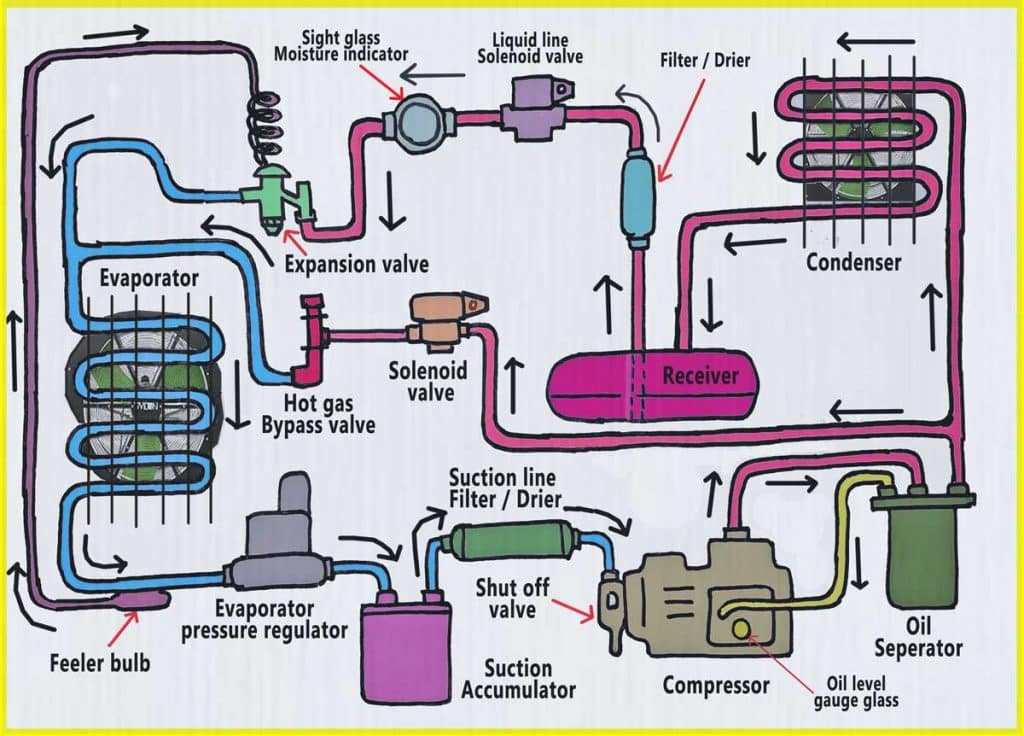Contents
- 1 Factors affecting an air handling unit (AHU)
- 2 What is a Comfort Zone in an Air Conditioning System?
- 3 Five Major Dry Air Problems From Air Conditioners | AC on Our Body
- 4 Effect of Legionella Bacteria in Air Handling Unit
- 5 Types of air handling units(AHU)
- 6 Role of Psychrometric Charts in AHU systems
Factors affecting an air handling unit (AHU)
The higher the temperature of the air, the more water vapour it can hold, that’s why our sweat feels sticky in the summer season, this is known as humidity, extremes of which can be uncomfortable.
The atmosphere contains a number of water particles in suspension due to the evaporation of water at sea, lakes, ponds etc., which takes place at all temperatures. The number of suspended water particles held in the air depends on the air capacity.
At any given temperature, the air can only hold a certain amount of water particles at which point it is said to be saturated, any reduction in temperature will then cause excess vapor to be condensed back into the water leading to Rain.
Air conditioning is vital to the comfort of those living in higher humid areas.
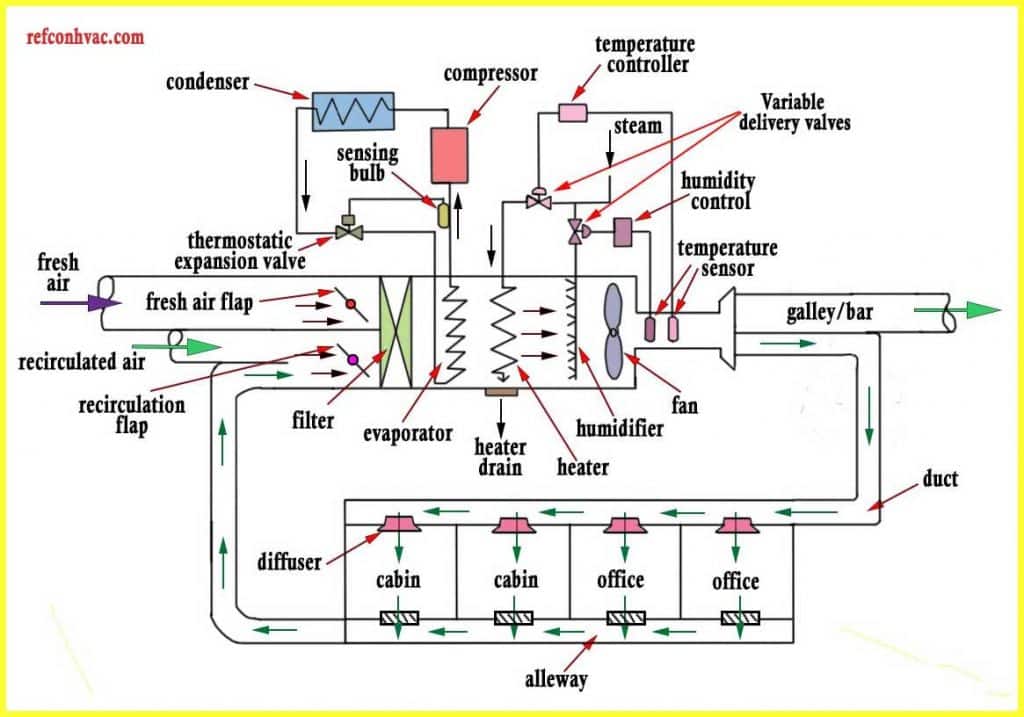
AHU (Air Handling Unit) comfortable conditions depend mainly upon:
- Temperature
- Humidity
- Cleanliness of air
- Velocity of air
Relative Humidity on AHU
When the air is cooled, it becomes saturated (100%). This highly saturated air is not good for health. If this air is inhaled, then we may get a cough, cold, and chest infection.
Also, moisture might get condensed on electronic equipment. Considering all this, dehumidification is required to reduce humidity to around 50%.
The humidity or wetness of the atmosphere is the percentage of water held in suspension at any given temperature against the total water quantity which could be held at saturation. This is termed as relative humidity.
Surface water and rain keep moisture in the atmosphere everywhere at all times.

Dew Point
The effect of raising the relative humidity beyond the saturation point causes condensation, the temperature at which this occurs is called Dew Point temperature.
At saturation point, any reduction in the temperature of air results in the VAPOR condensing back into the water. If the atmosphere is not saturated, then any reduction in temperature causes condensation immediately.
Specific humidity
It is the ratio of the mass of water vapour to the mass of dry air in a given volume.
Dry bulb temperature
An ordinary thermometer measures the Dry Bulb temperature.
Wet bulb temperature
This is the temperature measured by a thermometer which has its bulb covered with a wetted fabric.
As the moisture in the fabric evaporates, a cooling effect is produced, resulting in a lower temperature than if the bulb was dry. The rate of evaporation from the wetted fabric depends upon the dryness of the air.
The difference between the wet and dry bulb temperatures is a measure of the humidity.
A dry and wet bulb thermometer housed in a casing (hygrometer) and swung in the air gives the relative humidity when both of the two readings are plotted on the psychometric chart.
What is a Comfort Zone in an Air Conditioning System?
Temperature alone does not determine whether or not a human is going to be comfortable, consider the following.
Air-cooled to a suitable temperature of 21°C.
But having a relative humidity of 100%; means that a person’s perspiration would not evaporate. It would be uncomfortable thus, relative humidity is important.
The comfort zone is a set of temperatures and relative humidities in which the human body is considered comfortable.
The boundaries are:
| R.H | DRY AIR TEMPERATURE | COMMENTS |
|---|---|---|
| 70% | Less than 20℃ | Too Cold |
| 70% | More than 27℃ | Too Warm |
| 40% | Less than 22℃ | Too Cold |
| 40% | More than 29℃ | Too Warm |
To obtain relative humidity of the air a wet and dry bulb psychrometer must be used. This is also called a wet and dry bulb hygrometer.
One relatively simple way of determining the R.H. is by using a wet and dry bulb instrument. A stream of air flow when past a thermometer having a wetted sleeve around the temperature recorder.
The temperature falls due to the evaporation from the wetted sleeve, and as a result, there is a transfer of heat from the air to the wetted sleeve, known as the wet bulb temperature.
Five Major Dry Air Problems From Air Conditioners | AC on Our Body
Air becomes dry when heated; dry air is uncomfortable for occupants.
Effects of dry air
- Eyes become dry.
- Skin dryness.
- Itching and scratching of the skin.
- Nose bleeding.
- Legionella
For this reason, it is necessary to have the humidity increased using a humidifier which injects live steam to increase humidity.
Effect of Legionella Bacteria in Air Handling Unit
Legionella is a bacteria which can be fatal to humans; it is present in areas of stagnant water where it can grow between temperatures of 20°C and 45°C, with rapid growth at 36°C.
To prevent infection, systems should be designed to prevent water from collecting and becoming stagnant.
The air conditioning system must be designed such that no water accumulates in the system, but mostly in Air Handling Unit (AHU) is more prone to water accumulation.
Therefore, drain from the air conditioning systems must be kept clear, and air filters must be cleaned at regular intervals with super-chlorinated water of 50 ppm.
The humidifier, evaporator and heater coils should be cleaned with the super-chlorinated solution.
Legionnaires are disease usually starts suddenly with flu-like symptoms and develops into a form of pneumonia. Very few people exposed to the bacteria can contract the disease and avoid disease spread from person to person.
As the disease is very similar to flu, it is not easy to identify, and the doctor must take tests to confirm, the disease may take up to a week to develop.
In a case of Legionnaires disease a confirmed person can normally be treated with antibiotics, the incident must be reported to the health authorities.
Main areas of danger and countermeasures in the Air Conditioning system
- Air intakes Mainly down to good design, ensuring efficient drainage
- Filters Should be easily accessible for cleaning with a super-chlorinated solution (50 PPM).
- Humidifiers Clean regularly with a super-chlorinated solution.
- Insulation This should be removed if wet
Types of air handling units(AHU)
Single Ducted Air handling unit
A typical system for providing air conditioning consists of a central system which
- Cools
- Heats
- Dehumidifies
- Humidifies
There are many designs of air conditioning systems
Depending on the climate the air is heated or cooled in the central system, and delivered via ducting to individual wall mounted cabin units fitted with an electric heater to allow individual temperature control.
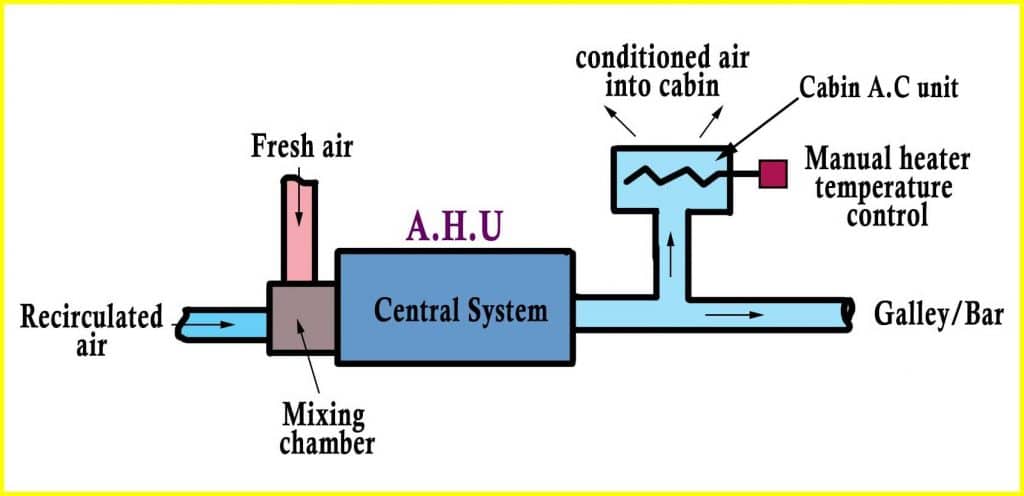
With the air shut off the unit can be used as a radiator source
- In warm weather, the air is first cooled, as the temperature falls its humidity rises until it reaches 100% relative humidity, further cooling results in water removal from the air. The air may be reheated to reduce the relative humidity before passing into the accommodation. A percentage of exhaust air recirculated to no more than 60%.
- In cold weather the air is first heated, as the temperature rises, humidity falls. Steam may be sprayed into the air to increase the humidity.
Dual Ducted Air handling unit
This system allows for greater individual control of air temperature within cabins; it also maintains a better circulation of air as the temperature in the cabin varies.
The air supplied in two ducts into the individual cabins.
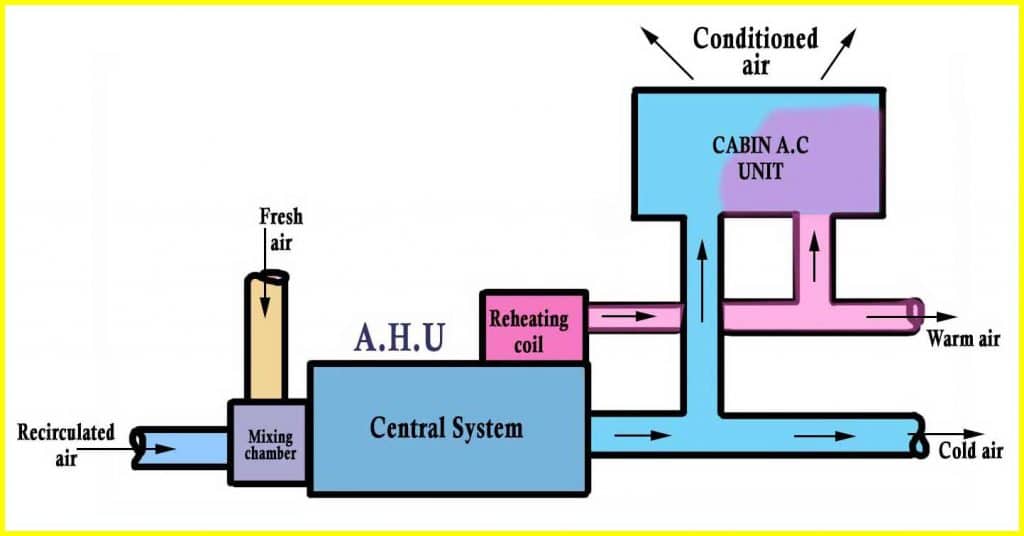
- In cold weather, the air gets preheated to the lowest supply temperature required, part of the air again reheated to a higher temperature. By mixing the two air supply, an individual can easily control his/her cabin temperatures.
- In warm weather, the air is cooled by the cooling coil in the central system, again part of the air reheated before distribution into the individual cabins where it gets mixed.
Role of Psychrometric Charts in AHU systems
- Comfort zone: (+24°C ± 1°C ).
- Relative humidity: 50% to 60%.
- Air movement: 4.5 to 7.5 meter/min.
Warm climate
- Air has a dry bulb temperature of 35°C and relative humidity of 45%, hence from chart wet bulb temperature is equal to 25°C.
- Air passed through the cooler to reduce dry bulb temperature to 22°C relative humidity from chart 100%.
- Air further cooled (dehumidified) 12°C and relative humidity 100%.
- Air heated to 24°C to bring it into a comfort zone with relative humidity 50%.
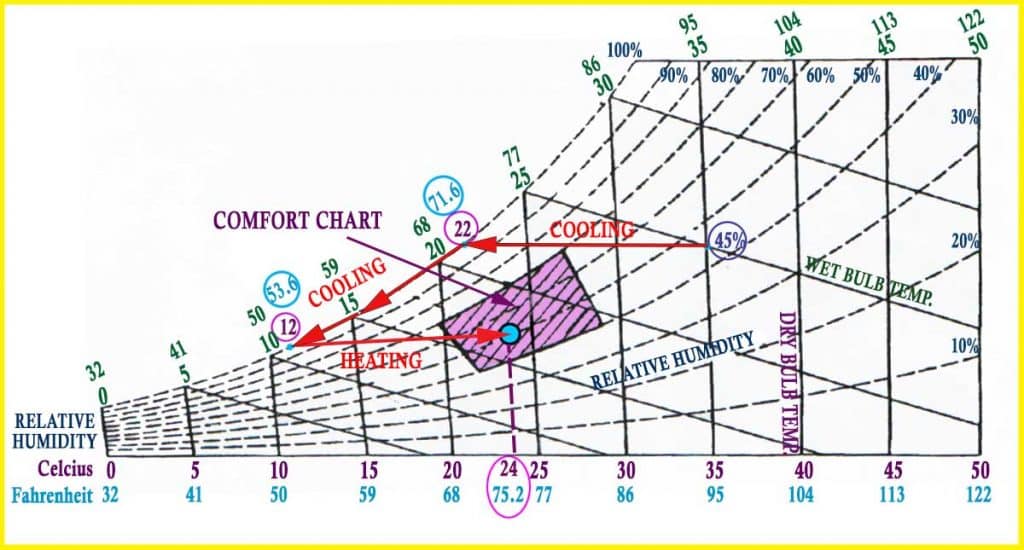
Cold climate
- Air has a dry bulb temperature of 0°C and relative humidity 20%
- Air passed through pre-heater and heated to 27°C at relative humidity 8%.
- Air now Re-humidified to increase its humidity to 100% at 12°C.
- Air is further heated in re-heater to a dry bulb temperature of 24°C hence humidity 50%.
- Air is now inside the comfort zone.
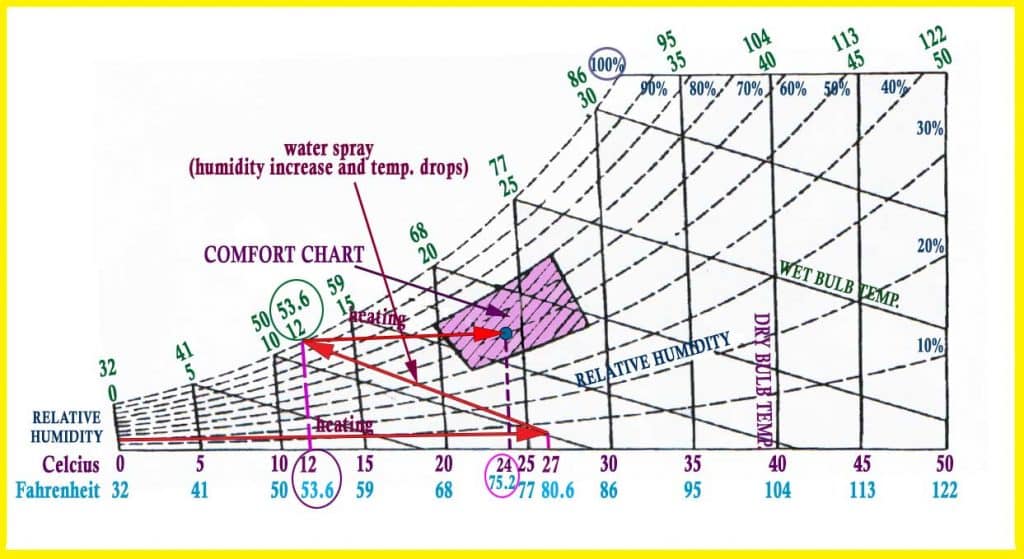
The systems, fans, and ducting are designed to give a minimum capacity of at least 7 litres/second/ person, the capacity related as the number of fresh air changes per hour; the air change depends upon:
- Size of room
- Use of room
- Not less than the total capacity of the accommodation exhaust fans.
- Temperature required (taking into account outside temperature).
Typically the quantity being anywhere between 6 to 30 air changes per hour
- accommodation 19 changes
- office/Bar 12 changes
- galley 20 changes
The ideal conditions for comfort vary considerably between one person and another. Therefore we use a range of temperature/humidity within which most people feel comfortable; this range is called the comfort zone.
The best degree of summer comfort are:
Relative humidity 50% temperature 22°C.
To prevent people suffering from ‘Cold shock’ the outdoor to indoor temperature should not exceed temperature differential of about 7°C.

